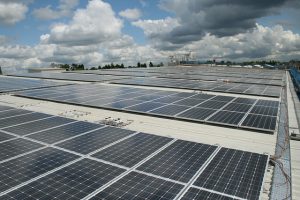Apple on Wednesday said it would take further major steps to green its huge supply chain in China, pledging it would work with its suppliers to produce 2.2 gigawatts (GW) of solar power and other renewable energy by the end of the decade.
The world’s biggest company by market capitalisation said it would build 200 megawatts (MW) of solar projects in different areas of China to provide low-carbon electricity to most of the companies that supply it with raw materials, components and assembly.
Apple also said it had completed 40MW of solar projects in Sichuan Province, which has enabled the company’s 19 corporate offices and 24 retail stores in China to be classified as ‘carbon neutral’.
The US tech giant said it was “driving its manufacturing partners to become more energy efficient and to use clean energy for their manufacturing operations,” a move that has prompted Foxconn to contribute 400MW of renewable energy to the effort.
Foxconn, Apple’s largest supplier, has committed to generate as much clean energy as its sprawling
Zhengzhou factory consumes in final production of the iPhone.
“I hope that this renewable energy project will serve as a catalyst for continued efforts to promote a greener ecosystem in our industry and beyond,” said Terry Gou, founder and CEO of Foxconn in the joint statement with Apple.
Earlier this year Apple had flagged up plans to make its suppliers
switch to renewable energy, but commitments from huge companies such as Foxconn are likely to give further momentum to a potential greening of China’s manufacturing sector.
In the past few years China has rolled out a slew of
overlapping policies, laws, targets and initiatives aim to curb production and consumption of coal-fired power, as China looks to low-carbon energy to improve air quality in its smog-shrouded cities and slash greenhouse gas emissions.
The central government’s
‘Made in China 2025’ initiative, which was adopted in 2013, envisages that more of the country’s manufacturing base will become increasingly sophisticated by the middle of the next decade, using renewable energy either produced onsite or through so-called smart grids.
One of the main challenges for big assembly plants will be to store solar energy so that the power of the sun can be harnessed at night-time, as many of China’s big electronics manufacturing operations run 24/7.
But traditional sectors such as steel, chemicals and cement, which account for most of China’s coal demand,
will likely remain heavy users of the highly-polluting fuel despite shutdowns of old plants and shuttering of surplus capacity.





